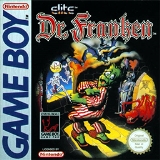
Dr. Franken
Encyclopedia
Dr. Franken was a video game released for Game Boy
and Super NES
by Elite Systems
. It was titled The Adventures of Dr. Franken for the SNES in the United States
.
The game features Franky, a Frankenstein
Monster on a mission to collect the scattered body parts of his girlfriend.
Prototype
NES
and Sega Game Gear
versions were developed around the same time, but never officially released.
throughout. The title screen music is Fugue No. 2 In C Minor BWV 847 (The Well Tempered Clavier in C), and the gameplay music is Beethoven's Moonlight Sonata. The GameBoy and NES versions' music was arranged by Mark Cooksey
. He composed the music in C-Lab Notator for the Atari ST
.
Game Boy
The , is an 8-bit handheld video game device developed and manufactured by Nintendo. It was released in Japan on , in North America in , and in Europe on...
and Super NES
Super Nintendo Entertainment System
The Super Nintendo Entertainment System is a 16-bit video game console that was released by Nintendo in North America, Europe, Australasia , and South America between 1990 and 1993. In Japan and Southeast Asia, the system is called the , or SFC for short...
by Elite Systems
Elite Systems
Elite Systems is a UK video game developer and publisher established in 1984 as Richard Wilcox Software. They are best known for producing home computer conversions of popular arcade games...
. It was titled The Adventures of Dr. Franken for the SNES in the United States
United States
The United States of America is a federal constitutional republic comprising fifty states and a federal district...
.
The game features Franky, a Frankenstein
Frankenstein
Frankenstein; or, The Modern Prometheus is a novel about a failed experiment that produced a monster, written by Mary Shelley, with inserts of poems by Percy Bysshe Shelley. Shelley started writing the story when she was eighteen, and the novel was published when she was twenty-one. The first...
Monster on a mission to collect the scattered body parts of his girlfriend.
Prototype
Prototype
A prototype is an early sample or model built to test a concept or process or to act as a thing to be replicated or learned from.The word prototype derives from the Greek πρωτότυπον , "primitive form", neutral of πρωτότυπος , "original, primitive", from πρῶτος , "first" and τύπος ,...
NES
Nintendo Entertainment System
The Nintendo Entertainment System is an 8-bit video game console that was released by Nintendo in North America during 1985, in Europe during 1986 and Australia in 1987...
and Sega Game Gear
Sega Game Gear
The was Sega's first handheld game console. It was the third commercially available color handheld console, after the Atari Lynx and the TurboExpress....
versions were developed around the same time, but never officially released.
Game Boy Edition
The Game Boy release of the game uses a password-based saving system to save the player's progress. The game consisted of seven floors where various items and parts of Bitsy (Franky's girlfriend) were hidden. Keys and special items were needed to access additional areas to find more body parts and equipment required to resurrect Bitsy.Music
The Gameboy and unreleased NES versions of the game used two classical music pieces by BachBạch
Bạch is a Vietnamese surname. The name is transliterated as Bai in Chinese and Baek, in Korean.Bach is the anglicized variation of the surname Bạch.-Notable people with the surname Bạch:* Bạch Liêu...
throughout. The title screen music is Fugue No. 2 In C Minor BWV 847 (The Well Tempered Clavier in C), and the gameplay music is Beethoven's Moonlight Sonata. The GameBoy and NES versions' music was arranged by Mark Cooksey
Mark Cooksey
Mark Cooksey is a Commodore 64 musician, best known for composing the music for the platform game Ghosts'n Goblins. He was employed by the UK video game developer and publisher Elite Systems....
. He composed the music in C-Lab Notator for the Atari ST
Atari ST
The Atari ST is a home/personal computer that was released by Atari Corporation in 1985 and commercially available from that summer into the early 1990s. The "ST" officially stands for "Sixteen/Thirty-two", which referred to the Motorola 68000's 16-bit external bus and 32-bit internals...
.

